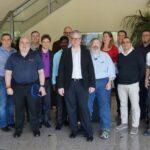|
|

Christos Karamanolis presented for VMware by Broadcom at SFD7 |

This video is part of the appearance, “VMware Presents at Storage Field Day 7“. It was recorded as part of Storage Field Day 7 at 9:00-11:00 on March 12, 2015.
Watch on YouTube
Watch on Vimeo
In the VMware Virtual SAN Technical Discussion presented by Christos Karamanolis on March 12, 2015, Christos delves into the architectural decisions and goals behind VMware’s vSAN. He begins by explaining the primary objectives set out when vSAN was conceived about four and a half years prior. The main goal was to create a storage product tailored for VMware vSphere customers, focusing on providing a compelling product with a low total cost of ownership. This includes both capital expenditure (CAPEX) and operational expenditure (OPEX), emphasizing affordable performance and ease of management. Christos highlights the importance of integrating vSAN with existing VMware products and features to ensure a seamless operational experience for customers, facilitating easy adoption.
Christos then discusses the architectural principles applied in vSAN, starting with the decision to go with a hyper-converged infrastructure. This approach was chosen to streamline procurement, deployment, and operations, allowing customers to grow their compute and storage resources in tandem without disrupting existing data center network architectures. He explains that vSAN is a distributed software product running on every ESX hypervisor in a cluster, aggregating local storage resources and presenting them as a single virtual data store accessible by all hosts in the cluster. This design avoids bottlenecks by eliminating special roles such as gateways or metadata servers. Christos also emphasizes the integration of critical parts of the storage product into the ESX kernel, which optimizes properties like latency and minimizes CPU cycles per I/O operation, crucial for delivering cost-effective performance.
The presentation also covers the manageability and monitoring aspects of vSAN, which are crucial for its integration into existing VMware environments. Christos explains that vSAN is designed to be managed using the same workflows and tools familiar to vSphere administrators, such as maintenance mode and HA (High Availability). He highlights the importance of providing a seamless management experience, allowing administrators to manage storage as part of their existing vSphere clusters without needing additional management concepts or tools. The discussion also touches on the challenges of certifying hardware for vSAN, given the vast array of controllers, flash devices, and magnetic disks that need to be qualified. Despite these challenges, VMware is committed to offering a flexible, software-defined storage solution that can be tailored to meet the diverse needs of its customers.
Personnel: Christos Karamanolis









